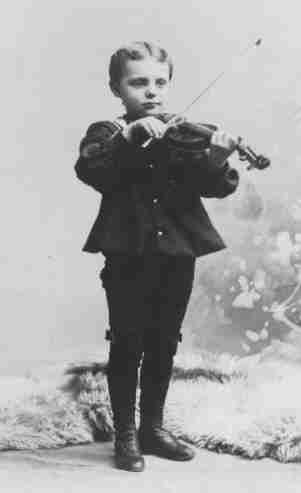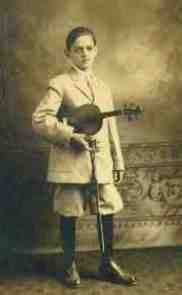
Figure 1 2.--This boy in the late 19th Century, probably the 1890s, wears a sailor suit to be photographed with his violin. Notice the buttons on his middy blouse and the little bows on his kneepants.

There was no costume of course for boys learning musical instruments. Mothers insisted, however, that there sons put on their best suits for any recitals or performances. Dress standards in recent years have become more casual, but mothers usually insist on something beyond "t" shorts and jeans. Here we will archive both photographs taken at recitals and formal portraits that HBC believe show the kind of clothes boys wouls have worn to their recitals. Until fairly recently it was difficult for partents to actually photograph their son's performance at a recital.
The clothing standards at recitals and performances have varied over time with changing fashions.
I do not yet have good information on what boys may have worn for
recitals during the early and mid-19th Century. I think recitals as
we nowvknow them may have been less common. Children during this
period probably played for the family, but less commonly in any public
venue.
Large numbers of photographic portraits become available in the late 19th century. In part this was a reflection of the declining cost of a photographic portrait. HBC believes that the increasing prposperity of America and Europe also meant that there were increasing numbers of family that could aford instrumental lessons for their children. Given the age of the boys being taught to play instruments, most would be dressed in kneepants suits for recitals or portraits. Often large floppy bows would be added. Sailor suits, usually with kneepants, appear to have been popular choices. Interestingly, relatively few boys appear to have worn Fauntleroy suits. Perhaps age was a factor.
American boys generally wore knee pants or knicker suits. Eurpean boys, especially by the 1910s, began wearing short pants suits, although older boys might wear knicker suits. Sailor suits were still very common, especially in Germany.

Figure 2.--Standard recital dress for older American boys in the 1910s were knickers. |
American boys continued dressing up for their recitals. After the war they sometomes wore informal, open collar shirts without ties. Suits were more varies, and recitals might include boys in short pants, knickers, and long pants.
No information avilable yet.
No information avilable yet.
Boys have taken clases to learn to play musical instruments from time immemorial. European families in the 19th Century were very private. Boys taking music lessons were lees likely to pefrorm in public. Toward the end of the Century the institution of the recital for music students became increasingly accepted. One begins to read about music recitals in Europe and America during the 1870s and 1880s. There was no costume of course for boys learning musical instruments. Mothers insisted, however, that there sons put on their best suits for any recitals or performances. Dress standards in recent years have become more casual, but mothers usually insist on something beyond "t" shorts and jeans. The styles of clothes have varied somewhat between different countries and are thus a good reflection of dressy boys' clothing in the various countries.
Related Chronolgy Pages in the Boys' Historical Web Site
[Main Chronology Page]
[The 1880s]
[The 1930s]
[The 1940s]
[The 1950s]
[The 1960s]
[The 1970s]
[The 1980s]
Navigate the Historic Boys' Clothing Web style pages:
[Kilts]
[Caps]
[Sailor suits]
[Sailor hats]
[School uniform
[Scout
